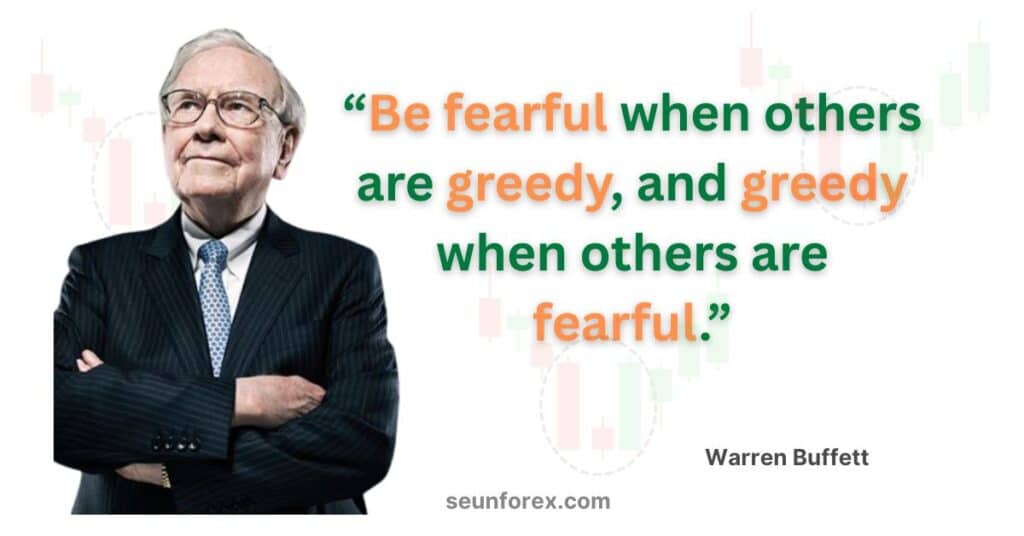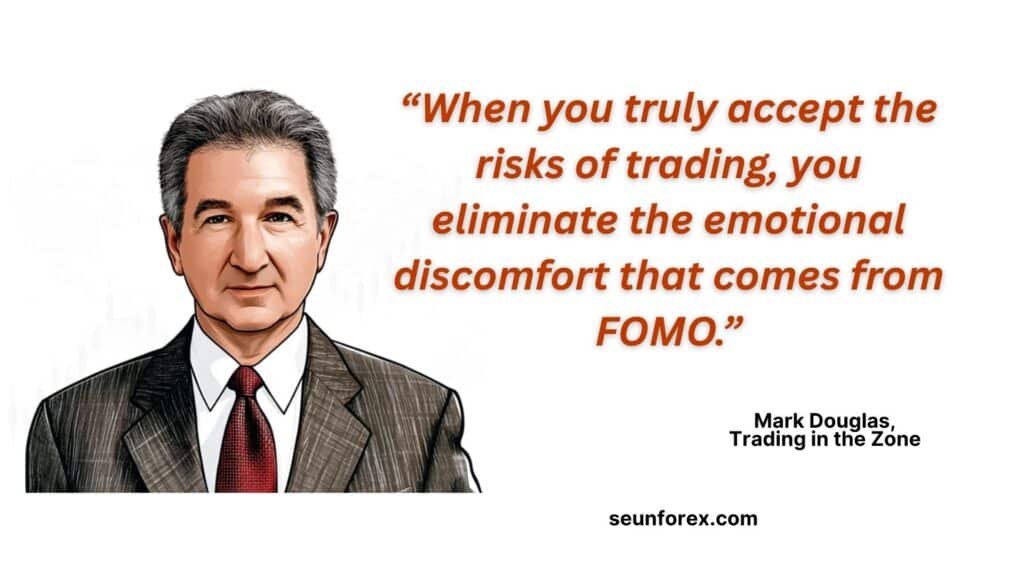
“The secret to trading is to have no ego. To the extent you can eliminate ego, you eliminate FOMO.” Paul Tudor Jones II
That heart-pounding, gut-wrenching feeling is universal. You see a trade rocketing upwards without you, and the Fear of Missing Out takes over. Your finger hovers over the buy button as the green candle stretches, a monument to your indecision. Your brain screams, “Get in! You’re missing it!”
So you click. You chase. You enter at the top. The reversal is inevitable. As your position bleeds red, you blame your weak mindset. Everyone tells you the key is to “control your emotions.” But what if that advice is missing the real point?
What if the true secret to how to stop FOMO isn’t found in meditation, but in a checklist?
This is the harsh truth: FOMO is a planning problem, not an emotional one. It is not the cause of your losses, but the final alarm that your trading system has failed. That feeling of FOMO is a signal of strategic unpreparedness.
Trying to “control the emotion” is like silencing a check-engine light without ever opening the hood. The traders who truly overcome FOMO don’t just have more willpower; they have a better playbook. They have built a fortress of rules that makes temptation irrelevant.
This is how you can shift your mindset for FOMO and build that fortress for yourself.
Part 1: Redefining FOMO – From Feeling to Feedback
FOMO is a Symptom, Not the Disease
Think of two scenarios:
Scenario A: A stock you have had on your watchlist for weeks, awaiting a pullback to the 50-day moving average, suddenly hits your precise entry level. You enter calmly. This is not FOMO. This is execution.
Scenario B: A meme stock you have never researched gaps up 80% pre-market. You see the ticker flooding social media. Your friends are making money. You panic-buy at the open, only to watch it collapse an hour later. This is FOMO.
The difference is not the emotion of “not wanting to miss out.” That feeling is present in both.
The difference is the context of your plan.
In Scenario A, the plan provided a filter. The setup was pre-defined. The emotion was a quiet confirmation of a logical process.
In Scenario B, the absence of a plan created a vacuum. Your brain, terrified of ambiguity and opportunity cost, flooded the void with adrenaline and panic.
FOMO is simply the body’s physiological response to strategic unpreparedness.
As the classic trading text Trading Habits emphasizes, you must “Build your system on quantifiable facts, not opinions.”
“I don’t want to miss this rally” is an opinion.
“This stock has broken out of a 6-month base on volume 300% above average” is a quantifiable fact.
FOMO thrives in the gap between the two.
The Two Types of “Missing Out”
To dismantle FOMO, you must understand its two distinct forms:
- Missing a Planned Opportunity: This is an execution error. Your plan identified the setup, but you hesitated, froze, or second-guessed your rules. The remedy for this is drilling your process and building discipline. The emotion here is regret, not panic.
- Missing an Unplanned Opportunity: This is the true heart of destructive FOMO. You had no framework to evaluate the move. It was not on your radar. The sudden surge creates a cognitive dissonance: “Is this real? Should I be in? What do I do?” Your brain, lacking a pre-programmed response, defaults to the tribal instinct of “follow the herd.”
The core argument is this:
A well-defined plan turns ambiguous, panic-inducing “opportunities” into clear, categorizable “setups” or “noise.”
It gives you the power to say, with conviction, “This is not my trade,” and watch it fly without a flicker of doubt.
Part 2: The 4 Planning Failures That Create FOMO

FOMO does not appear out of thin air. It is the direct byproduct of specific, correctable failures in your trading framework. To genuinely overcome FOMO, you must first diagnose and address these four critical planning breakdowns. This is the core of shifting your mindset for FOMO from one of emotion to one of execution.
⚠️ Failure #1: The Unclear Entry/Exit Strategy
This is the most common root of the FOMO problem and a major hurdle for those trying to stop FOMO in its tracks. Without a predefined, non-negotiable rule for entering and exiting, every price movement feels like a potential opportunity. This ambiguity turns you from a strategic trader into a reactionary one, directly fueling the fear of missing out.
- The FOMO Trigger:
You see a stock or forex pair surging. With no clear entry criteria, you’re trapped in a mental tug-of-war: “Should I buy now? What if it pulls back? What if it never pulls back?” This internal chaos is the essence of FOMO trading and leads to impulsive market entries at the worst possible moments—peak price, maximum risk. - The Planning Antidote:
Your plan must provide definitive, non-negotiable answers. It should state clearly: “I will only enter a long position if [Condition A] and [Condition B] are met.”
*Example: “I will buy ONLY IF the price breaks above yesterday’s high AND the 5-period RSI is above 60.”*
If those conditions are not met, it is not a valid trade. This simple checklist is your first and most powerful defense, transforming panic into precision and systematically helping you overcome FOMO.
💡 Pro Tip: A solid plan requires a reliable platform. If you’re building your foundation, ensure you’re using a trusted broker that supports consistent execution. Our [Best Forex Brokers for Beginners Guide] walks you through choosing a platform that matches your strategy—a crucial step in preventing FOMO before it ever begins.
Failure #2: The Absent “Watchlist”
An unfocused mind is fertile ground for FOMO. If you are staring at a blank screen or an endless list of thousands of tickers, you are strategically vulnerable. Fear of missing out actively preys on this lack of preparation.
Without a curated list of assets you deeply understand, every market move looks like a potential opportunity, making it impossible to stop FOMO from dictating your actions.
- The FOMO Trigger: A random crypto or small-cap stock you’ve never analyzed suddenly starts pumping. It wasn’t on your radar, but now it’s all you can see. The absence of a defined watchlist forces you to make a high-stakes evaluation under extreme pressure—a task the human brain is notoriously bad at. This is the exact moment undisciplined FOMO trading begins.
- The Planning Antidote: You must operate from a strictly curated watchlist. This is your “universe of opportunity.” You have done the homework; you know the key levels and behaviors. When a ticker outside this list goes parabolic, your plan’s response is simple and empowering: “That is not in my universe. It is not my trade.”
This rule is incredibly liberating. It doesn’t just manage FOMO; it systematically transforms FOMO into disciplined focus, ensuring you only act on your genuine, pre-defined edges.
Failure #3: Poor Risk & Position Sizing Rules
This is the engine of FOMO. When you do not know exactly how much you can afford to lose, the stakes feel infinitely high.
The fear of a catastrophic loss battles with the greed of a life-changing gain. This internal war manifests as FOMO.
- The FOMO Trigger: You see a move and you do not know if you should bet $100 or $10,000. This uncertainty creates paralysis. It is followed by an impulsive, often oversized, entry. Now you are in a trade that is too large for your psyche. Every tick against you feels like a disaster.
- The Planning Antidote: The sacred 1% Rule. As Trading Habits dictates: “Never lose more than 1% of capital on a single trade.” Your plan must calcify this. Before every trade, you know your precise stop-loss level and your precise position size. The risk is defined, quantified, and accepted before you enter. This eliminates the fear of a “big loss,” which is the primary fuel for FOMO. “Position sizing is your thermostat.” If you are sweating, you are trading too big.
Failure #4: Lack of an “If/Then” Framework
The market is dynamic. The best plans account for multiple scenarios.
Without pre-decided “if/then” contingencies, you are forced to react to events in real-time. This is when emotion takes over.
- The FOMO Trigger: The market is ripping higher at the open. Your plan says “do not chase,” but what does that mean? Without a specific rule, the ambiguity creates stress. “Is this still a chase? What if this is the real breakout?”
- The Planning Antidote: Your plan must be a series of conditional statements.
- “IF the market gaps up more than 1%, THEN I will not open new long positions for the first 30 minutes.”
- “IF a stock on my watchlist rallies 5% in 5 minutes on no news, THEN I will classify it as ‘noise’ and remove it from consideration for the day.”
- “IF I feel the urge to enter a trade that does not meet my criteria, THEN I will walk away from the screen for 15 minutes.”
This is what veteran traders mean by: “Be disciplined with risk, flexible with the market.”
Your “if/then” framework is the embodiment of that flexibility within a disciplined structure.
Part 3: The Antidote – Building a FOMO-Proof System

Knowing the failures is useless without the fix. Here is the actionable, step-by-step process to build a system that inoculates you against FOMO.
Step 1: Define Your Edge in Writing
Your “edge” is your statistical reason for believing you can be profitable. It is your filter. It is the answer to the question: “What is a valid opportunity for me?”
- Action: Write down your exact criteria for a trade. Is it a breakout from a consolidation pattern? A pullback to a moving average in a long-term trend? A specific earnings-play structure? Be so precise that a computer could nearly execute it. This document is your contract with the markets. When FOMO tempts you, you point to the contract.
Step 2: Create a Concrete, Un-Ignorable Playbook
This is the physical manifestation of your plan. It cannot live in your head, where emotions can easily edit it.
- Action: Create a trading journal template that forces you to answer these questions before every single trade:
- Setup: What is the specific pattern? (e.g., Bull Flag Breakout)
- Entry Trigger: What exact candle or print makes me enter? (e.g., Break of yesterday’s high)
- Stop-Loss: Where is my invalidation point? (e.g., Low of the breakout candle)
- Profit Target: Where do I take profits? (e.g., 1.5x Risk, or at prior resistance)
- Position Size: How many shares/contracts am I trading? (Calculated via the 1% rule)
- Checklist: Does this trade meet all my criteria? (Yes/No)
If you cannot fill out every field, you are not allowed to trade. This is non-negotiable.
Step 3: Implement the “Pre-Mortem” Ritual
This powerful technique is how you weaponize hindsight before the trade. It directly counters the impulse of FOMO trading by leveraging a simple truth: the psychological phenomenon we call FOMO, or the Fear of missing out, is rooted in anxiety over social and opportunity-based regret. Your job is to make that regret impossible.
Before you enter, fast-forward and imagine the trade has already been a complete failure.
- Action: The moment before you click, you must ask one critical question: “When I review this losing trade in my journal, what will be the documented reason for taking it?”
- If the honest answer is, “Because it perfectly met my predefined criteria,” then execute the trade with confidence.
- If the answer is, “Because I had a fear of missing out,” or “Because it was going up,” you must physically walk away.
This single habit installs a circuit breaker in your brain. It creates the non-negotiable pause that is essential for anyone learning how to stop FOMO. This ritual separates the disciplined professional from the impulsive gambler. It ensures your actions are driven by your plan, not by the panic of being left behind.arning how to stop FOMO. This ritual is what permanently separates the disciplined professional from the impulsive gambler, ensuring your actions are driven by your plan, not by panic.
Step 4: Embrace “JOMO” (The Joy Of Missing Out)
This is the promised land. JOMO is the profound sense of peace and confidence that comes from knowing you stuck to your plan and avoided a bad decision.
- Action: Actively celebrate your “misses.” When you watch a stock you felt FOMO for skyrocket and then crash, add it to a “JOMO List” in your journal. Write down: “On [Date], I felt FOMO on [Ticker] but stuck to my plan. It would have been a X% loss. My plan protected me.” This reframes “missing out” from a failure to a success. It provides positive reinforcement for your discipline. The greatest joy for a trader is not the thrill of a win. It is the quiet pride of a disaster avoided.
Final Thought: FOMO is a Choice
We have been sold a lie: that FOMO is an external force that acts upon us.
It is not.
It is the internal consequence of an internal choice—the choice to trade without a plan.
The traders who consistently profit are not emotionless robots. They feel the same impulses you do.
The difference is, they have built a system that renders those impulses powerless. Their plan is the cage that holds the beast.
As the wisdom in Trading Habits concludes, great trading is a habit game.
The habit of pre-market preparation.
The habit of precise position sizing.
The habit of journaling.
The habit of the pre-mortem.
Stop trying to manage the emotion of FOMO. Start fixing the planning failures that cause it.
Your plan is not a restriction. It is the weapon that liberates you from the tyranny of every flashing price and market headline.
Master your plan, and you will find that the fear of missing out has been replaced by the joy of staying in control.